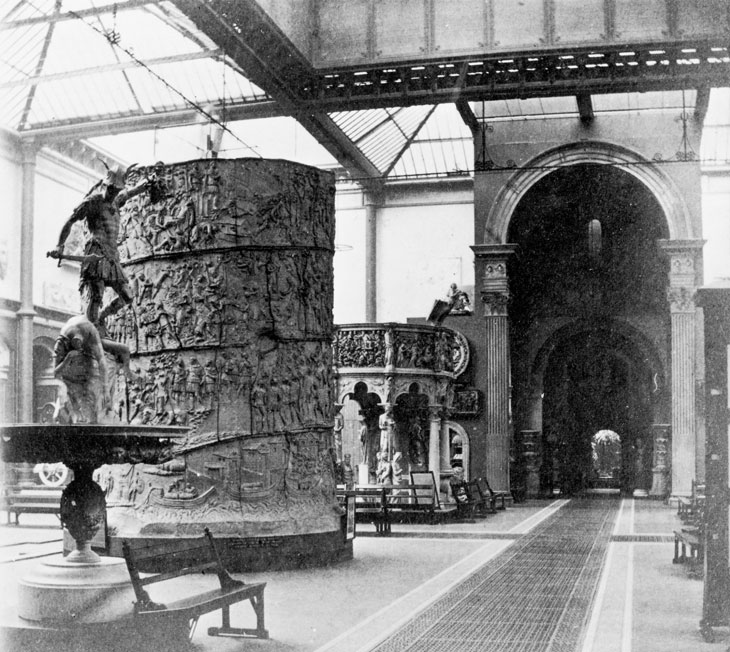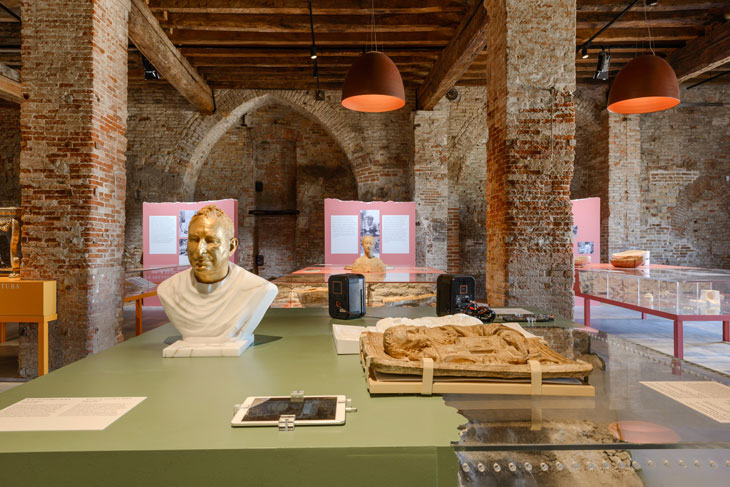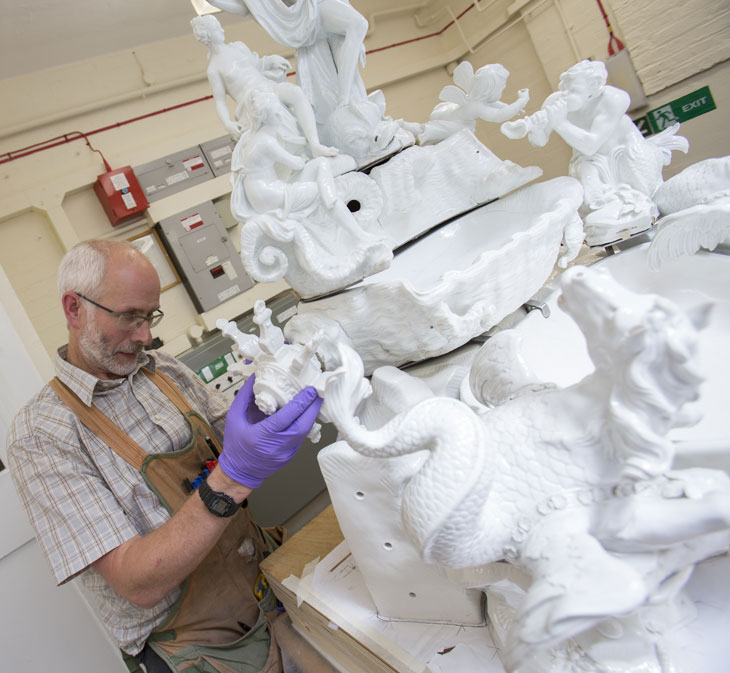In 1867, the founding director of the Victoria and Albert Museum, Henry Cole, released the ‘Convention for Promoting Universally Reproductions of Works of Art for the Benefits of Museums of All Countries’. The declaration was conceived in response to the rise of new technologies – specifically plaster-casting, electrotyping and photography – that enabled artefacts to be recorded and reproduced more accurately and efficiently than ever. Cole was quick to recognise the potential of these copies as educational tools, and the Cast Courts at the V&A are a lasting testament to his vision. Few who visited the South Kensington Museum could make a Grand Tour to the monuments of historic Europe, so Cole brought the monuments to them, as reproductions. With the convention, he hoped to encourage other museums to do the same, and to share copies widely for the sake of ‘public instruction’.

V&A Cast Courts, late 19th century. © Victoria and Albert Museum, London
Cole and his colleagues would be astounded at the technological advances of the past 150 years. Today, digital cameras can record a scene in ultra-high resolution, and photogrammetry can stitch photographic data into complex 3D models. Drone technology enables people to study monuments and landscapes from previously impossible vantage points. Hi-tech scanners can record surface details with unprecedented accuracy, and milling cutters or 3D printers can replicate them with increasing levels of finesse. Modern threats to global heritage, such as climate change, urbanisation, mass tourism, and regional conflicts, have brought the potential of these new technologies to preserve and record history to public attention, and hastened their development. In addition to photographic archives, we now have vast online image databases; where once we made plaster casts, we can now visit entire heritage sites in replica, leaving the originals untouched.
These are powerful tools that are changing fundamentally the ways in which museums and other heritage organisations study, record, and reproduce cultural artefacts. How should we be using them? It’s a question that the V&A asked publicly at the Venice Biennale of Architecture last year with its ‘A World of Fragile Parts’ exhibition, which ‘explored the threats facing the preservation of global heritage sites and how the production of copies can aid in the preservation of cultural artefacts.’ And it’s one to which the institution returned last week with the launch of a new declaration on the ‘Reproduction of Art and Cultural Heritage’ (ReACH), 150 years after Henry Cole first laid out his guiding principles on the topic.

Installation view of ‘A World of Fragile Parts’, Venice Architecture Biennale 2016
ReACH is the product of conversations that sprang from ‘A World of Fragile Parts’, between the V&A, Factum Arte, and the Peri Charitable Foundation, but drafting it has been a global affair. During the eight-month consultation process, round-table discussions were held first at the headquarters of UNESCO in Paris, and subsequently in Washington, D.C. (at the Smithsonian), St Petersburg (at the Hermitage), London, Abu Dhabi and Beijing (at the Palace Museum), before a draft of the convention was drawn up and approved by key partners. The range of organisations invited to contribute was kept deliberately broad, encompassing NGOs and start-ups in addition to museums and heritage bodies, while the resulting document is kept just as deliberately short. It is intended (as the V&A’s director, Tristram Hunt, put it at the launch), to kick off a ‘proper global conversation’ about the issues at stake.
The declaration retains the spirit of Cole’s original: at its heart lies the same conviction that ‘works of art and cultural heritage should be preserved and shared as widely as possible throughout the world.’ To this is added a call to share expertise, in recognition of the fact that ‘the means and skills required to use and access digital technology are not distributed evenly around the world.’ Further guidelines on the creation and storage of reproductions acknowledge the importance of future-proofing archives: as technology continues to evolve at a rapid pace, it is essential that existing records be properly managed, filed and maintained in formats that will not become corrupted or obsolete. The paper also makes the case for transparency and open access, calling for all those producing reproductions of cultural artefacts to be clear about their reasons for doing so, to record their methods, and to make the results discoverable.

Conservation of Meissen table fountain at the V&A. © Victoria and Albert Museum, London
How to achieve these goals remains open to debate, and – as a symposium held to accompany the launch proved – plenty of other questions remain. How, for example, can museums encourage people to interact with digital resources once they are published? (All too frequently, digitisation projects enjoy a flurry of public interest in the weeks after their launch, but fail to maintain it.) What can cultural institutions do to bridge the digital divide, and reach the millions of people who still lack access to the internet? Can digital heritage projects rely on public and political support? While there is widespread enthusiasm for some projects, such as the documentation and reconstruction of threatened monuments in the Middle East, other campaigns to combat the effects of climate change or urban development might meet with a less favourable reception. Accompanying these pragmatic considerations are several enduring philosophical and ethical questions. What does it mean to make a copy? What makes something authentic? Where do we draw the line between virtual reality and ‘real’ life?
These conversations must continue, for at least as long as the technologies themselves continue to evolve. And as more and more projects are launched around the world, the potential benefits of collaborating and sharing information – and the costs of not doing so – will only increase. Those behind ReACH are already planning further events and meetings, seeking new signatories, and urging the public to read, share and offer feedback on the document. ‘We don’t care if it is ripped apart, reworked, renounced,’ Hunt explained. ‘Until now, there has not been enough dialogue.’ A declaration on its own won’t change anything, but dialogue might. If ReACH can provide both a framework and a network for future debates, it will be a step in the right direction at a time when international cooperation is needed more than ever.
For more information on ReACH (Reproduction of Art and Cultural Heritage), visit the V&A’s project page here.

Why it’s time to talk seriously about digital reproductions
Installation view of 'A World of Fragile Parts', Venice Architecture Biennale 2016
Share
In 1867, the founding director of the Victoria and Albert Museum, Henry Cole, released the ‘Convention for Promoting Universally Reproductions of Works of Art for the Benefits of Museums of All Countries’. The declaration was conceived in response to the rise of new technologies – specifically plaster-casting, electrotyping and photography – that enabled artefacts to be recorded and reproduced more accurately and efficiently than ever. Cole was quick to recognise the potential of these copies as educational tools, and the Cast Courts at the V&A are a lasting testament to his vision. Few who visited the South Kensington Museum could make a Grand Tour to the monuments of historic Europe, so Cole brought the monuments to them, as reproductions. With the convention, he hoped to encourage other museums to do the same, and to share copies widely for the sake of ‘public instruction’.
V&A Cast Courts, late 19th century. © Victoria and Albert Museum, London
Cole and his colleagues would be astounded at the technological advances of the past 150 years. Today, digital cameras can record a scene in ultra-high resolution, and photogrammetry can stitch photographic data into complex 3D models. Drone technology enables people to study monuments and landscapes from previously impossible vantage points. Hi-tech scanners can record surface details with unprecedented accuracy, and milling cutters or 3D printers can replicate them with increasing levels of finesse. Modern threats to global heritage, such as climate change, urbanisation, mass tourism, and regional conflicts, have brought the potential of these new technologies to preserve and record history to public attention, and hastened their development. In addition to photographic archives, we now have vast online image databases; where once we made plaster casts, we can now visit entire heritage sites in replica, leaving the originals untouched.
These are powerful tools that are changing fundamentally the ways in which museums and other heritage organisations study, record, and reproduce cultural artefacts. How should we be using them? It’s a question that the V&A asked publicly at the Venice Biennale of Architecture last year with its ‘A World of Fragile Parts’ exhibition, which ‘explored the threats facing the preservation of global heritage sites and how the production of copies can aid in the preservation of cultural artefacts.’ And it’s one to which the institution returned last week with the launch of a new declaration on the ‘Reproduction of Art and Cultural Heritage’ (ReACH), 150 years after Henry Cole first laid out his guiding principles on the topic.
Installation view of ‘A World of Fragile Parts’, Venice Architecture Biennale 2016
ReACH is the product of conversations that sprang from ‘A World of Fragile Parts’, between the V&A, Factum Arte, and the Peri Charitable Foundation, but drafting it has been a global affair. During the eight-month consultation process, round-table discussions were held first at the headquarters of UNESCO in Paris, and subsequently in Washington, D.C. (at the Smithsonian), St Petersburg (at the Hermitage), London, Abu Dhabi and Beijing (at the Palace Museum), before a draft of the convention was drawn up and approved by key partners. The range of organisations invited to contribute was kept deliberately broad, encompassing NGOs and start-ups in addition to museums and heritage bodies, while the resulting document is kept just as deliberately short. It is intended (as the V&A’s director, Tristram Hunt, put it at the launch), to kick off a ‘proper global conversation’ about the issues at stake.
The declaration retains the spirit of Cole’s original: at its heart lies the same conviction that ‘works of art and cultural heritage should be preserved and shared as widely as possible throughout the world.’ To this is added a call to share expertise, in recognition of the fact that ‘the means and skills required to use and access digital technology are not distributed evenly around the world.’ Further guidelines on the creation and storage of reproductions acknowledge the importance of future-proofing archives: as technology continues to evolve at a rapid pace, it is essential that existing records be properly managed, filed and maintained in formats that will not become corrupted or obsolete. The paper also makes the case for transparency and open access, calling for all those producing reproductions of cultural artefacts to be clear about their reasons for doing so, to record their methods, and to make the results discoverable.
Conservation of Meissen table fountain at the V&A. © Victoria and Albert Museum, London
How to achieve these goals remains open to debate, and – as a symposium held to accompany the launch proved – plenty of other questions remain. How, for example, can museums encourage people to interact with digital resources once they are published? (All too frequently, digitisation projects enjoy a flurry of public interest in the weeks after their launch, but fail to maintain it.) What can cultural institutions do to bridge the digital divide, and reach the millions of people who still lack access to the internet? Can digital heritage projects rely on public and political support? While there is widespread enthusiasm for some projects, such as the documentation and reconstruction of threatened monuments in the Middle East, other campaigns to combat the effects of climate change or urban development might meet with a less favourable reception. Accompanying these pragmatic considerations are several enduring philosophical and ethical questions. What does it mean to make a copy? What makes something authentic? Where do we draw the line between virtual reality and ‘real’ life?
These conversations must continue, for at least as long as the technologies themselves continue to evolve. And as more and more projects are launched around the world, the potential benefits of collaborating and sharing information – and the costs of not doing so – will only increase. Those behind ReACH are already planning further events and meetings, seeking new signatories, and urging the public to read, share and offer feedback on the document. ‘We don’t care if it is ripped apart, reworked, renounced,’ Hunt explained. ‘Until now, there has not been enough dialogue.’ A declaration on its own won’t change anything, but dialogue might. If ReACH can provide both a framework and a network for future debates, it will be a step in the right direction at a time when international cooperation is needed more than ever.
For more information on ReACH (Reproduction of Art and Cultural Heritage), visit the V&A’s project page here.
Unlimited access from just $16 every 3 months
Subscribe to get unlimited and exclusive access to the top art stories, interviews and exhibition reviews.
Share
Recommended for you
Digital replicas are not soulless – they help us engage with art
Rather than seeing replicas as knock-offs, we should think of them like maps or models
What’s at stake in digitising heritage sites such as the Lascaux cave?
A new facsimile of the Lascaux cave is about to open, but are digital reproductions of cultural sites merely tourist attractions or will they save our fragile heritage?
Digital Innovation of the Year
Art UK This online database of art in UK public collections is an important resource with scholarly and popular appeal.…